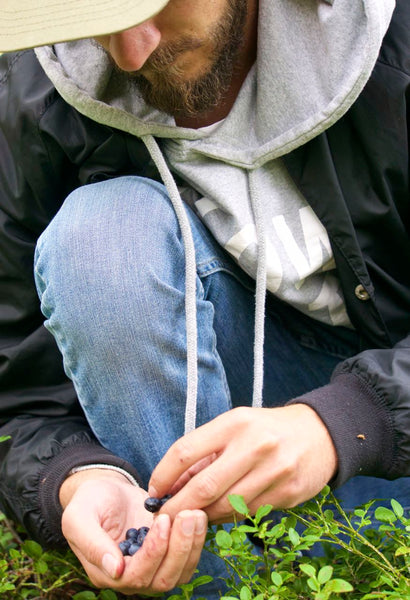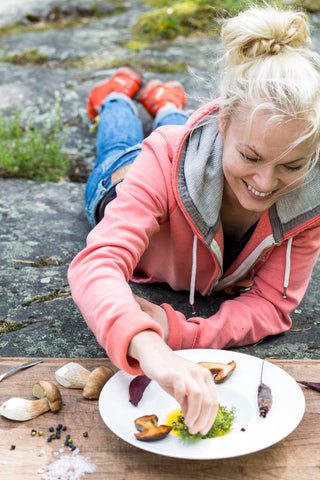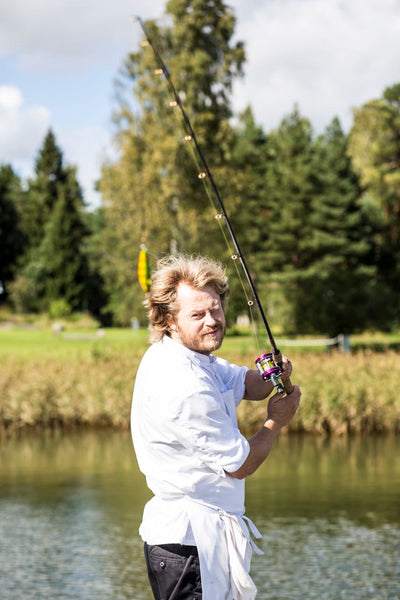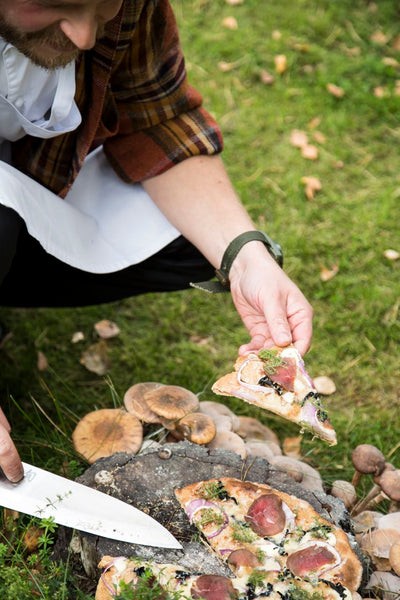In the past few years, the Nordic diet has been raising interest as a regional alternative for the well known Mediterranean diet as it highlights the use of healthy and seasonal foods. The main difference between the two diets is that the Nordic plants benefit from four completely different seasons whereas the Mediterranean plants enjoy a different growth environment as their summers are hot and dry with rainy winters. In the Nordic diet, fruits are replaced with wild berries and vegetables with cabbages. While Mediterraneans forage herbs such as wild basil, oregano and mint us Northeners pick ground elder, nettle and angelica.
In addition to our native wild plants such as berries, mushrooms, herbs and vegetables, a wholesome Nordic diet consists of natural foods like whole grain oats, peas, broad beans, potatoes, wild fish and, occasionally, game.
Rapeseed oil or canola oil is our common source of healthy fats. However, we at Helsinki Wildfoods prefer the nutty and rich taste of hemp instead. Hemp was one of the first crops cultivated in Finland and within the last two millennia it has adapted well to our demanding soil and weather. Hemp has a perfect balance of healthy omega-3 fatty acids and when peeled, the seeds are an ecological alternative for imported nuts! In addition to hemp, flaxseed are also an appetizing northern source of healthy fats.
Climate Friendly Nordic diet

As the name hints, the Nordic diet consists of foods that are sourced and eaten mainly in Finland, Denmark, Iceland, Norway and Sweden. One of the most impressive things about the regime is that it fits almost into every global food trend. The diet consists of nutritious, healthy, locally grown superfoods that also have small carbon footprints – not only when hand-picked, hunted or fished wild but also when naturally cultivated.
Our four seasons and special agro-climatic circumstances are what makes our cultivated plants so unique; the growing conditions are so extraordinary that they cannot be replicated anywhere else in the world! The endless summer nights and crisp Nordic winters are the features responsible for making our native plants true superfoods filled with antioxidants, vitamins and polyphenols. Even though the growing season is short here up north, it sure is profound. The seeds or sprouts are usually planted in May and harvested in August and September. During the summer the sun shines almost 20 hours a day in the southern Nordics and 24/7 in the Arctic parts of our region!
Our winters are extreme, there is no way around that. But the fact that our soil is frozen half of the year makes it so pure and clean. The tough winter provides a rough environment for harmful pests and that’s why we can use less pesticide residues when cultivating our native plants. Native plants tend to be more adaptive to their original surroundings and therefore there is no need to spray the crop with environmentally harmful chemicals.
Last but not least, we have amazingly clean nature and water in the Nordics. Plants need watering and the cleaner the water the cleaner the outcome. The Finnish nature has been ranked as the cleanest in of the whole world!
Wild Berries
In addition to being super tasty, it’s been shown that berries from Nordic forests can form a significant component of a healthy diet. This is largely due to their:
- high content of phenolic - compounds
- health-promoting seed oil
- low energy content
- high fibre content
- a wide range of vitamins, in particular C and E
- wide range of minerals yet a low sodium content
So far, wild berries of the north are the most studied plants of our wilderness. Unfortunately, there is still not enough comprehensive studies about our wild herbs and vegetables. Hopefully, this will change in the near future and in the wake of our wild herb revolution!
Wild Vegetables
Wild vegetables such as nettle, ground elder (goutweed), dandelion and angelica can be used as main ingredients in almost any savory dish and salad – the same way you would use spinach or kale. Although wild vegetables can be used in slightly larger doses than wild herbs, almost all almost all of our wild Nordic herbs and veggies may boost the metabolism and have an energizing effect due to their vitamin C content. So, start carefully and increase the amounts after you’ve gotten use to the rich tastes and nutrient content. The easiest way to start using wild vegetables in your cooking is to first spice your favorite dishes with them and then gradually raise them to main raw ingredients. Once you learn the many ways which you can use them, there is no turning back!
What to eat during the lengthy winter months when there aren't any fresh wild veggies available? That was one of the main reasons Helsinki Wildfoods' started to make products – to provide a Finnish and ecological alternative for imported vegetables and fruits, frozen wild berries and spinach. All of our products are dried mixes of natural Finnish plants that enjoy a long shelf life so they can be enjoyed throughout the four seasons. And, when soaked in a splash of water the dried ones are almost as juicy as fresh ones, especially when cooked.
Wild Herbs
Wild herbs such as yarrow, birch, spruce and rose root can be used in small amounts to spice up your meals and drinks. You can also brew healing tea out of them.
For centuries, our native herbs have played an important role in our folk medicine. Traditionally, natural plants were used as reeds in different forms such as wrappings, tinctures and syrups.
However, the herb being used should always be known fully; some wild herbs have more herbal effects than others and the intensity of the plant's remedial effects varies according to the place of growth and season. Always, start with caution; many wild herbs are not recommended for high doses, for continuous use or for pregnant women because there is not enough substantive data regarding their use as main ingredients.
Wild Mushrooms
There are more than two thousand mushrooms species in Finland of which a couple of hundred are edible and about twenty of them are considered extra delicious! The most popular mushrooms are the boletes, milk caps, chanterelles, and horn of plenty, to name a few.mushrooms growing in the Nordics as in other countries around the world.
Mushrooms are juicy, nutrient rich and environmentally friendly food which can be used as exciting spices or even as a main dish of its own. They are rich in essential minerals, proteins, vitamins and fiber and are low in fat. On the average, mushrooms contain more minerals than certain vegetables, most importantly potassium, phosphorus, zinc, selenium and copper. Mushrooms are a source of vitamin A, B and D. Especially the chanterelles and yellow-footed chanterelles which have plenty of D vitamin.
Recent studies have revealed that eating mushrooms is beneficial for the intestines and may even prevent dementia!
Attention! Some wild mushrooms, vegetables, herbs and berries can be poisonous or even deadly, so great care must be taken to know which ones to forage and consume. You can learn to forage wild herbs, vegetables and berries and hunt wild mushrooms on our workshops or let our publications guide the way.
Whole Grain Oats
Whole grain means that the whole grain is used, including all its layers. Bran is only the outer layer of the grain whereas powder, flakes and crush used in for example in our Wild Berry Bowl contains the whole grain grinded in different formats. Bran is particularly rich in dietary fibre and it gives our Wild Berry Bowl its pleasant texture. Finland is the only country that produces high volumes of top quality oats north of the 60th latitude. Arctic oats have been found to help reduce blood cholesterol levels.
Oats are used as a base ingredient in Nordic diet also in various other ways: as a dairy-free alternative for milk, cream or fraiche or even as a source of protein in Pulled Oats and Puhtikaura.
Birch Sugar (xylitol)
Birch sugar, xylitol, is a perfect natural sweetener for desserts, porridges, yoghurts and drinks. It contains 40% less calories than regular sugar, raises blood sugar slowly and has a glycemic index (GI) of only 7 (regular sugar has a GI of 68). According to research, birch sugar, xylitol, is good for teeth and it can also prevent ear infections. Birch sugar withstands heat extremely well so it’s perfect for baking as well!
Bonus! Helsinki Wildfoods’ xylitol is manufactured by DuPont, which makes xylitol from the side stream of hard wood processing. DuPont's technology allows high recovery of xylose using only minimum amount of chemicals and energy. All side streams of hard wood processing are utilised as energy after xylose removal and the small carbon footprint results predominately from DuPont ́s energy usage and transport of xylose.
Potatoes
Potatoes are one of the most common side dishes in the Nordic diet. Even though potatoes’ nutrition content is not as exciting as other Nordic foods, they have surprisingly low carbon foot print – lower than oats!
Psst! Potato flakes are the secret ingredient in our Nettle Pesto making its texture swell and velvety.
Root Vegetables
Root vegetables are a cheap, tasty, nutritious and ecological addition to the Nordic diet. There are over ten root vegetables growing in Finland but we tend to use only a handful of them: beetroot, swede and carrot to name a few.
Root veggies remain well so they are superb food in the winter time when the fresh local alternatives are missing. It's been a thrill to notice that Finnish producers have started to value these versatile and C vitamin rich foods and added them to their breads, veggie patties, ketchups, meats and ice creams to reduce the amount of not so beneficial ingredients. You can even make a vegan Gravlax alternative from carrots!
Flaxseeds
Flaxseeds are one of the first crops that humans have started to cultivate, and they grow extremely well in the Nordics. The health benefits of flaxseeds are based on the omega-3 fatty acids which every cell in the human body benefits from! Flaxseeds antioxidant is called lignan – sound familiar? If you thought of lingonberries, you’re right! Even though our lingonberries and rye contain also this beneficial antioxidant, flaxseeds have it 700 times more. Flaxseeds are also a good source of magnesium plus, they are a great way to add fibre and plant-based protein to your diet.
We have used flaxseeds in our Forest Salsa to give the mixture a smooth and decadent texture with the additional bonus of added fibre and healthy fats!
Hemp Seeds
Hemp seeds are good sources of both plant-based protein and fats. Hemp seeds contain all eight amino acids that are vital for our body. Hemp has also an amazing balance between the healthy omega-3 and omega-6 fats. These seeds contain a nice amount of vitamin E as well as lecithin, calcium, iron, iodine, magnesium, phosphorus and zinc. Plus, they are one of the only seeds that have also chlorophyll!
We added hemp seeds to our Nettle Pesto not only because of its nutrition content but also due its nut-like texture making our pesto a perfect alternative for those allergic to nuts. Unlike traditional pestos, our pesto is also suitable for vegans thanks to nutritional yeast flakes which replace cheese in our Nettle Pesto recipe.
Broad Beans
In addition to hemp and flaxseeds, broad beans are one of the first plants that have been cultivated by the human species. Broad beans are filled with protein which make them a perfect alternative for meat. The taste is mild but full – suitable for various vegan recipes.
Even though the cultivation of broad beans started 700 years ago in Finland, not until today has there been as many cool broad bean products available – salted snacks, pulled broad beans, flour, crush and patties. Peas and potatoes seized the cultivation area of broad beans for few centuries but luckily, the vegan trend has brought broad beans back to the Nordic kitchens.
Peas
Peas are a good source of protein and the secret ingredient behind all the new plant-based protein innovations such as Pulled Oats and Härkis. It's interesting that these two are marketed highlighting the awesomeness of oats and broad beans when in fact it's the peas that are making these products so rich in protein. Not claiming that oats or broad beans are a bad choice either but protein wise they just can't compete with peas. Peas have also good amount of amino acids which are essential for muscle growth, especially L-glutamine.
Cabbages
Cabbages are cheap and healthy veggies that enjoy our cold growing conditions. They contain satisfying amounts of vitamins, antioxidants and even polyphenols! Cabbages have also lots of fibre which is beneficial for our digestion. For some people cabbages might cause gas in the stomach but luckily, our wild veggies such as yarrow and dandelion and wild blueberries can ease these unpleasant side effects.
Tip! Sauerkraut or kimchi is a great way to enjoy cabbages – and easier for the belly too!

Wild Fish
Even though the shallow Baltic Sea is partly polluted in the coastlines of Finland, its condition is getting better due to strict conservation. In addition to the Baltic Sea we have plenty of fish in our hundreds of thousands of lakes. In Finland, a conscious Nordic diet consists of sustainably fished perch, pike, vendace, Baltic herring, Atlantic herring, roach and bream.
Even though some of these fish have been considered as trash fish before, their reputation is changing, and new exciting trash fish products are popping in the fish counters. One of our favorites is Järki särki – marinated and canned roach. Fish with lots of reeds such as roach and pike are an excellent source of protein and they turn into surprisingly tasty dishes when marinated or put through a meat grinder. Fish also contain D vitamin which northerners stuggle to maintain appropriate levels of during the long polar nights.
Tip! Note, that fish populations vary by each country. Check out the local seafood guides from WWF's website.
Game
Even though cutting down the consumption of dairy products and meat is one of the easiest ways to curb climate change, game is always a better option than produced meat. Game is almost fat free, and it has its own special nuanced taste.
None of us at Helsinki Wildfoods are totally absolute when it comes to following a certain diet and thus game meat can be part of our plant-based diets – preferably, in special occasions.
Did you know? Unlike produced meat, game meat has hardly any pathogens that could be transmitted from the animal to human
Sources:
danisco.com/fileadmin/user_upload/danisco/documents/products/2e_XIVIA_White_Paper.pdf
finnish-oats.fi/en/luminous-finnish-oat-the-arctic-treasure-for-you/
hidastaelamaa.fi/2015/03/kaali-on-aivoille-superruokaa/
linseed.fi/en/nutritional-values/
riista.fi/riistatalous/hyvinvointia-riistasta/ravintoa-riistasta/riistaruokien-terveysvaikutukset/
wwf.fi/kalaopas/
yle.fi/uutiset/3-8321893
Written by Pauliina Toivanen to HELSINKI WILDFOODS
Photos: Aino Huotari, Pauliina Toivanen





